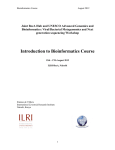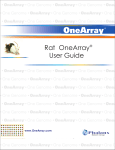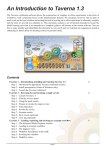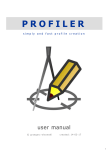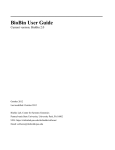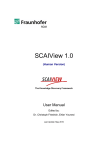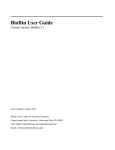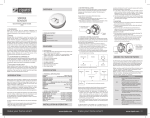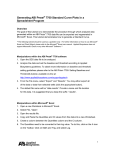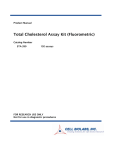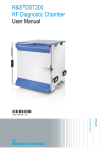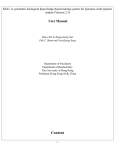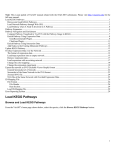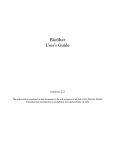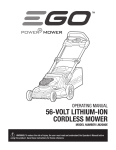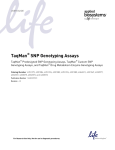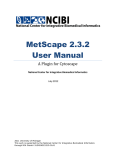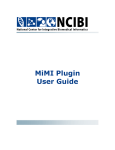Download biofilter - Biological Knowledge Integration Utility
Transcript
B I O F I L T E R R e f e re nce M a nua l re v. 1.0.1 biofilter - Biological Knowledge Integration Utility h t t p : / / c h g r. m c . v a n d e r b i l t . e d u / b i o f i l t e r Table of Contents Introduction! 1 Purpose of this manual! 1 Conventions Used! 1 Example commands! 1 biofilter sample.config --list-associations 1 Program Output! 1 Configuration details are listed first in bold- left aligned with the rest of the text.! 1 Common Parameters! 1 Integer! 2 Float! 2 Index! 2 max! 2 min! 2 On/Off! 2 filename! 2 label! 2 description! 2 Using the Biofilter Application! 3 Command-Line Arguments! 3 R i t c h i e L a b! biofilter-Reference 2 biofilter config-file [--S (--sample-config)]! 3 -C (--coverage) filename! 3 -D (--detailed-coverage)! 3 -d (--disease-dependent) filename! 3 --filter-by-genes filename|ALL! 3 --inject-gene-information analysis-results filename integer integer filename|ALL! 4 -G (--list-groups) [criteria]! 4 -L (--list-models) filename! 4 --model-report filename! 5 --marker-info! 5 -q --quiet! 5 --report-gene-coverage filename! 5 -s (--snps) filename! 5 --snp-report! 5 -W (--write-models) float integer! 5 -m (--show-models) filename! 5 -P (--list-population-ids)! 6 -d (--disease-dependent) filename! 6 -p (--print-count-estimates)! 6 --strip-optimization! 6 --optimize! 6 General Parameters! 7 R i t c h i e L a b! biofilter-Reference 3 The following parameters control the basic behavior of the application through configuration options.! 7 VARIATION_FILENAME filename! 7 VARIATION_FILENAME variations.bn 7 SETTINGS_DB filename! 7 SETTINGS_DB bio-settings.cn 7 MAX_GENE_COUNT integer! 7 MAX_GENE_COUNT 30 7 SNPS_SOURCE filename! 7 SNPS_SOURCE /projects/ritchie/biofilter/Affy6.0-v27.txt 7 INCLUDE_GROUPS group [group] [group] [...]! 7 INCLUDE_GROUP_FILE filename! 8 INCLUDE_GROUP_FILE ../group_list.txt MODEL_FILENAME filename! 8 8 MDOEL_FILENAME affy50-models.bin 8 DISEASE_DEPENDENT string! 8 DISEEASE_DEPENDENT alz-bio-knowledge.txt POPULATION string! 8 8 POPULATION NO-LD 8 MODEL_BUFFER_INIT integer! 8 MODEL_BUFFER_INIT 10000 8 MODEL_BUFFER_MAX integer! 8 MODEL_BUFFER_MAX 100000 8 MAX_GENE_COUNT integer! 9 MAX_GENE_COUNT 30 9 R i t c h i e L a b! biofilter-Reference 4 PREFERRED_ALIAS filename! 9 PREFERRED_ALIAS my_favoriate_genes.txt 9 LOAD_ALL_ALIASES YES/NO! 9 LOAD_ALL_ALIASES NO 9 REPORT_PREFIX string! 9 REPORT_PREFIX data/bio-alz 9 IMPLICATION_IDX_DUPLICATE_WEIGHT float! 9 IMPLICATION_IDX_DUPLICATE_WEIGHT 0.25 9 HTML_REPORTS YES/NO! 9 HTML_REPORTS YES DISEASE_DEPENDENT_LEVEL 9 ALL_MODELS/GROUP_LEVEL/DD_ONLY! 9 DISEASE_DEPENDENT_LEVEL DD_ONLY 9 COLLAPSE_ASSOCIATION_REPORT YES/NO! COLLAPSE_ASSOCIATION_REPORT YES 10 10 BINARY_MODEL_ARCHIVE YES/NO! 10 BINARY_MODEL_ARCHIVE YES 10 ASSOCIATION_REPORT YES/NO! 10 ASSOCIATION_REPORT YES 10 Input File Formats! 11 Preferred Aliases! 11 SNPS_SOURCE! 11 Disease Dependent Genes! 11 Disease Dependent Definition! 12 Disease Dependent File Format! 12 R i t c h i e L a b! biofilter-Reference 5 Model Production! 14 Overview! 14 Reports! 15 Coverage Report! 15 biofilter sample.config -s Illumina-660Quad.txt --report-gene-coverage alz-genes.txt -C Illumina-660Quad.txt 15 Model Summary Report! 17 Assocations List! 18 biofilter sample.config --list-associations 18 Disease Dependent Contents Report! 19 SNP Report! 20 biofilter sample.config --snp-report 20 SNP-SNP Model Report! 21 Gene-Gene Models! 22 Genes Report! 23 SNP Cleanup Report! 24 Output Control (TBD)! 25 Example Run - Alzheimer’s! 26 Listing Options! 26 $ biofilter 26 Generating Sample Configuration! 27 $ biofilter --sample-config > sample.config 27 28 Target Platform! Gene Aliases ! 29 R i t c h i e L a b! biofilter-Reference 6 biofilter sample.config -G alz 29 Report Prefix! 30 biofilter --list-associations 31 Population Selection and LD! 32 biofilter sample.config -P 32 Defining Disease Dependent Groups! 33 Model Generation! 34 biofilter sample.config -W 2.0 1000000 tutorial.gene-gene! 34 36 References! 38 R i t c h i e L a b! biofilter-Reference 7 Introduction Purpose of this manual Contained within this manual are details for configuring and running the application, biofilter. If this is your first time to use the software, we highly recommend that you take a few minutes to download and work through one or more tutorials. Then, once familiar with the capabilities of the software, users can refer to this guide when making changes to the basic configuration settings. Conventions Used There are two conventions used throughout this document. These text conventions are intended to help distinguish examples from configuration parameters. Example commands biofilter sample.config --list-associations The application itself will be named differently according to the platform it was compiled for. On Linux systems, it will be biofilter or biofilter64 depending on whether it runs on 32bit or 64bit systems. Windows and OS X will have be named slightly differently according to their platform as well. Program Output Program output will be in a gray box. Some lines will often be removed when the output is lengthy. Configuration details are listed first in bold- left aligned with the rest of the text. The first word(s) are the keywords which specify what is being changed. Each keyword (or phrase) has some number of parameters. These are listed in the order they should appear in the configuration line. In some cases, parameters can be repeated or are optional. Those are denoted inside []s. Configuration details are generally followed immediately by an example line: ! This is an example Examples show how an actual entry would look and are followed by some descriptive information to help the user understand how the example would affect the biofilter application runtime. Common Parameters R i t c h i e L a b S o f t w a r e! biofilter-Reference 1 There are a number of parameters which are used commonly across multiple configuration settings. In order to simplify the descriptions of the various properties of each command, we’ll describe those properties here, and just refer to them as if they were a type. Integer Parameters specified in this way just simply refer to a whole number. In general, these values should be equal to or greater than 0, except when specified otherwise. Float Values specified as float are decimal values. Index If a parameter is listed as an index, it refers to the index, starting at 1 the user wishes to select. max This is generally an integer value representing the upper bound of some value. In some cases, such as minor allele frequency, it might represent a floating point value. min This is generally an integer value representing the lower bound of some value. In some cases, such as minor allele frequency, it is possible that it represents a floating point value. On/Off These parameters accept a boolean, Yes/No type setting. Users can use ON/OFF or YES/NO to set them. filename When a configuration refers to a file for input or output, the filename is generally used. This can be either a fully qualified path (such as /home/torstees/wga) or it can specified as a path relative to the directory where the application was run (such as ../data/goodfilename). It can also be just a plain filename as long as the file itself is available from the directory in which the application was run. label A label refers to a parameter whose value can be any text string without whitespace. These labels are generally used for reporting but in many cases are used to determine filenames. As a result, users should avoid using unusual characters in the string that could possibly cause problems with filenames. Because spaces and tabs are used to separate each parameter on a given line, labels can not contain spaces. description A description is a chunk of text that can contain spaces. It will always be at the very end of a line and is generally optional. R i t c h i e L a b S o f t w a r e! biofilter-Reference 2 Using the Biofilter Application The biofilter stand alone application can be used for more than one purpose. As a result, execution may take more than one set of parameters. Many configuration parameters can be overridden on the command line. Those parameters are prepended with a specially designated keyword which is prefixed by a “-” sign. These parameters might take more than one value. Below is a list of the parameters currently supported by the biofilter application. All parameters except the configuration file are optional. Command-Line Arguments biofilter config-file [--S (--sample-config)] Config-file Specifies the filename to be used to control genomeSIMLAs overall specific behavior. If the configuration is available from within the current working directory, the filename alone is sufficient. If the filename exists in another directory, a fully qualified or relative path should be provided along with the filename itself. --sample-config (optional) This parameter takes no arguments and causes the output of the biofilter to generate a basic configuration based on the default settings (and any that have been overridden by other parameters) No other execution is performed. -C (--coverage) filename filename Adds a file to the coverage report list. Coverage files contain RS IDs for a platform used for a coverage report. -D (--detailed-coverage) Causes the coverage report to provide more detailed information. -d (--disease-dependent) filename filename Adds a disease dependent group to the system. This is the same as adding a DISEASE_DEPENDENT line to the configuration file. --filter-by-genes filename|ALL R i t c h i e L a b S o f t w a r e! biofilter-Reference 3 filename File containing the genes to be used as a filter. Each gene should be on a separate line Generates a comma separated file containing the chromosome in the first column and the RS ID in the second, followed by each gene contained within that region in subsequent columns. Only SNPs that are found in one or more of the genes in filename will appear in the file. A new report is generated. It’s name is based on the REPORT_PREFIX configuration, with the last portion of the filename being snp-report.csv. --inject-gene-information analysis-results filename integer integer filename|ALL filename - This is the file containing comma separated values for each SNP in the analysis integer - This is the column in which the chromosome is found (this should start with 1). The chromosome should be 1-22, X, Y, MT integer - This is the column in which the rsid is found (the index should start with 1). filename - This is the file containing genes which are of interest. If the user wants to consider all genes, she can choose “ALL” as the filename. When the biofilter performs injection, it actually parses the specified CSV file and attempts to append any gene information associated with each SNP in the file. The genes that will be identified will be chosen from the second filename parameter, and will use the gene boundary extension conventions described elsewhere (either using LD Spline for a given population, or using a predetermined constant extension up and downstream of the real gene boundaries). A new report is generated. It’s name is based on the REPORT_PREFIX configuration, with the last portion of the filename being snp-analysis.csv. -G (--list-groups) [criteria]! criteria (optional) This string can be used to search the group’s name and description. If a match is found, the Meta Group name, group ID, group name and group description are displayed for each match. If this command appears as the last flag on the command line, all groups will be listed. This list does not refer to any setting other than the value at SETTINGS_DB. As a result, all groups that are part of the SETTINGS_DB are considered regardless of restrictive group limitations set within the configuration. -L (--list-models) filename filename The name of the model file from a previous run. R i t c h i e L a b S o f t w a r e! biofilter-Reference 4 This produces a basic model report. --model-report filename filename File containing pairwise snp models. Each line contains a single pairwise model listed as integer values separated by whitespace. --marker-info Produce haploview compatible marker-info files based on the SNPS_SOURCE platform. -q --quiet Turns off all non-vital output to stdout and stderr. --report-gene-coverage filename filename This file holds the list of genes for which coverage is to be reported in the coverage report. -s (--snps) filename filename This overloads the setting, SNPS_SOURCE, from the configuration file. --snp-report Produces a report containing all genes associated with each of the SNPs found in SNPS_SOURCE -W (--write-models) float integer Produces the gene-gene models, and optionally produces SNP-SNP models as well. float (optional) Minimum Implication Index - Set this value to the value of the minimum implication index you wish to use. integer (optiona) Number of models - Set this value to the number of models you wish to examine. This number takes precedence over the minimum implication index (i.e. if there are more models with implication index of 3 or greater, and the minimum implication index is 2.0, you will still only get models with an implication index of 3 or 4. -m (--show-models) filename filename Filename indicates the name of the model file (file produced during --write-models command). This produces the SNP-SNP Model report. R i t c h i e L a b S o f t w a r e! biofilter-Reference 5 -P (--list-population-ids) Lists the populations available in the database in use. Populations are used to adjust the gene boundaries to include additional SNPs that are observed to be within an LD threshold. By default, there should be 4 populations, with 3 to 6 different LD thresholds each. -d (--disease-dependent) filename filename This is a specially formatted file which contains user defined group information associated to disease specific knowledge. This is a command-line version of the configuration parameter, Disease Dependent Groups. A single run can have 0 or more disease specific files. -p (--print-count-estimates) This flag forces the application to produce a Gene-Gene model report. --strip-optimization This command causes the application to drop all of the Indexes. This can be done to speed up the insertions necessary during LD imports. Once the data has been properly imported, users should be sure to optimize the data once again. --optimize This adds indexes to the underlying database, if they don’t exist. This is generally only done once, but can be removed prior to performing LD import (see --strip-optimization above). Users generally shouldn’t need to use this command. R i t c h i e L a b S o f t w a r e! biofilter-Reference 6 General Parameters The following parameters control the basic behavior of the application through configuration options. VARIATION_FILENAME filename VARIATION_FILENAME variations.bn This sets the path to the source file containing the binary variation data. This file should originally be downloaded with the application, however, as the data is updated, this file can be downloaded independently of the database. There is the possibility that the file is incompatible with the version of the biofilter in use. In such cases, the application will exit with an appropriate measure. To resolve this issue, the user should download the latest version of the application as well. SETTINGS_DB filename SETTINGS_DB bio-settings.cn This sets the path to the settings database. This file is required for all biofilter functionality and will periodically updated with new information. Users generally will be able to update their settings file without updating the application, however, in the event that major changes have been identified, the file require a newer version of the application. In this event, users will be notified and will have to update their software to use the newest data. MAX_GENE_COUNT integer MAX_GENE_COUNT 30 This sets the upper limit for acceptable group size. Acceptable group size is the number of genes contained by a given group. If a group has as many or fewer genes in it, the biofilter uses it’s contents to generate models. If a group exceeds this number, the biofilter queries each of it’s children groups, performing the same check. This setting is used to constrain the size of the resulting model counts to a number that is manageable according to modern computation resources. SNPS_SOURCE filename SNPS_SOURCE /projects/ritchie/biofilter/Affy6.0-v27.txt This setting allows the user to limit the SNPs considered to a specific platform (or some user-defined set of SNPs). By setting this value, the biofilter only loads SNP data for those found in the source. INCLUDE_GROUPS group [group] [group] [...] This allows the user to limit the search to those groups (and their children). This can be a specific group within a meta-group or it can be a meta-group ID (such as DIP). Each group is separated by spaces and is the group’s unique ID. When including a group, all of that groups children are also included. R i t c h i e L a b S o f t w a r e! biofilter-Reference 7 INCLUDE_GROUP_FILE filename INCLUDE_GROUP_FILE ../group_list.txt This functions identically to INCLUDE_GROUPS, however the source is a text file. This allows users to include a very large number of specially selected groups (and their children). MODEL_FILENAME filename MDOEL_FILENAME affy50-models.bin This sets the output filename for the binary model file. DISEASE_DEPENDENT string DISEEASE_DEPENDENT alz-bio-knowledge.txt This instructs biofilter to load the knowledge associated with the file, alz-bio-knowledge.txt. A description of the format of these files can be found here. POPULATION string POPULATION NO-LD Setting the population for a given run allows the user to tap into expanded region boundaries associated with a particular LD cutoff and a given population. biofilter comes with a set of populations based on LD data found in hapmap, but users can contribute their own data. The string used as the parameter is one of a set of values known to the application. Users can query the application for a list of the valid settings by using the --list-populations flag. MODEL_BUFFER_INIT integer MODEL_BUFFER_INIT 10000 The model buffer is an internal data structure which is used to maintain the massive amount of models generated without requiring huge amounts of RAM. This number is used to determine how large the buffer is at start. The buffer object will always have at least MODEL_BUFFER_INIT models in memory at one time, and can grow as large as MODEL_BUFFER_MAX + MODEL_BUFFER_INIT during the processing. For systems with 1 gigabyte of RAM or less should use the default values. Increasing the init size will simply reduce the number of disk reads, and thus speed up the processing at the cost of increasing the actual memory foot print during processing. It is recommended that the init size be 1/4 the size of the max or smaller. MODEL_BUFFER_MAX integer MODEL_BUFFER_MAX 100000 This number represents the size the buffer can get before triggering a disk write. Larger values will increase performance, and could reduce the number of disk reads by reducing the number of cycles required. On 32bit Redhat intel systems, setting the MODEL_BUFFER_MAX to 20,000,000 allowed very fast processing of 500K sources with a memory footprint of 2.5 Gigabytes. The same setting for a million SNP source took 30 minutes and required 2.8 Gigabytes. Adding even more memory to the 64bit brought the run down to about 17 minutes R i t c h i e L a b S o f t w a r e! biofilter-Reference 8 (500,000,000 MAX_BUFFER). The same 1 million SNP source took over 2 hours at 4,000,000 but the footprint was around 1 gigabyte. MAX_GENE_COUNT integer MAX_GENE_COUNT 30 During model production, the biofilter ignores groups that exceed this value. This is done to avoid generating too many models (which defeats the purpose, to some extent). PREFERRED_ALIAS filename PREFERRED_ALIAS my_favoriate_genes.txt The user specifies a list of gene aliases which they prefer. These aliases are used in place of the Ensembl ID in subsequent reports. See formatting details for help creating the file. LOAD_ALL_ALIASES YES/NO LOAD_ALL_ALIASES NO Loads all region aliases (gene names) and generates a report report-prefix.aliases. This makes it easier for the user to lookup the Ensembl IDs that are used by default in the reports. REPORT_PREFIX string REPORT_PREFIX data/bio-alz When a report is produced that is sent to file instead of std-out, it will use the value of REPORT_PREFIX as the first part of the file name. Acceptable options can be anything that is acceptable for the filesystem except for whitespace (i.e. don’t use spaces or tabs). IMPLICATION_IDX_DUPLICATE_WEIGHT float IMPLICATION_IDX_DUPLICATE_WEIGHT 0.25 Disease dependent (DD) and disease independent (DI) groupings contribute differently toward the implication index. For DD groupings, only those groupings which produce the gene-gene model are counted. Each one counts one point. For DI groupings, we add a single point for each unique group where at least one gene is present. For each DI grouping where both genes are present, the IMPLICATION_IDX_DUPLICATE_WEIGHT is added to the final score. HTML_REPORTS YES/NO HTML_REPORTS YES When set to yes, most reports will be written in html format. DISEASE_DEPENDENT_LEVEL ALL_MODELS/GROUP_LEVEL/DD_ONLY DISEASE_DEPENDENT_LEVEL DD_ONLY Users can choose to filter models based on their association with disease dependent genes. When set to ALL_MODELS (default), all models will be produced. When set to GROUP_LEVEL, only groups where gene-gene models are R i t c h i e L a b S o f t w a r e! biofilter-Reference 9 produced that has one or more genes found in a disease dependent group will yield models. When set to DD_ONLY, only the gene-gene models in which one of the genes is found in one of the disease dependent groups are produced. COLLAPSE_ASSOCIATION_REPORT YES/NO COLLAPSE_ASSOCIATION_REPORT YES When set to yes, the associations shown reflect only the groups which could generate models. The report properly respects the MAX_GENE_COUNT setting, but it does not obey the DISEASE_DEPENDENT_LEVEL setting (it shows all groupings, despite their relationship with disease dependent groups). BINARY_MODEL_ARCHIVE YES/NO BINARY_MODEL_ARCHIVE YES Setting this value to YES causes the gene-gene model archive and the snp-snp model archive to be written in binary format. In most cases, this won’t be necessary, since both files will probably be reasonable in length. However, if either are expected to contain more than a few hundred thousand entries, it is recommended to use. ASSOCIATION_REPORT YES/NO ASSOCIATION_REPORT YES When Yes, this causes the biofilter to produce an association report. R i t c h i e L a b S o f t w a r e! biofilter-Reference 10 Input File Formats With very few exceptions, files are space delimited ascii files. Preferred Aliases This file provides one or more common gene names which can be substituted for Ensembl IDs in reports. Aliases must be alphanumeric (no spaces) and must match an alias known to the biofilter. Known aliases are those that were found in Ensembl’s external synonyms associated with EntrezGene & Uniprot (TrEMBL and Swiss-Prot). Currently, only aliases which map back to a single Ensembl Gene ID are used. This file is present only as a convenience for the user and is optional. Example file: NMT1 FURIN NRD1 S100B ATP2A2 SNPS_SOURCE The SNP Source file contains all SNPs to be used in the analysis. Generally, this will match the SNPs from the platform to be used in the analysis. However, it is also possible to use a highly restricted set for other types of analysis (such as identifying which genes a set of interesting SNPs might be found in.) The format is very simple. List all RS IDs in their integer format. Each ID should be separated by whitespace. 10000169 10000185 10000201 1000022 10000226 1000025 10000255 10000266 Disease Dependent Genes R i t c h i e L a b S o f t w a r e! biofilter-Reference 11 Users can tag genes as being disease dependent and add grouping information. Assigning genes to disease dependent groups causes two things to happen: First, it allows the user to increment the implication index of disease dependent genes for every disease dependent meta-group they assign it to. Second, by providing groups of genes that have been known to be related to a given disease, it is possible to add models that represent interactions that a highly relevant to the disease that might not exist in more traditional grouping paradigms. Disease Dependent Definition Users can create many disease dependent groupings. A high level grouping (or meta-group) will contain one or more group. Each of these groups will contain one or more regions. At present, the biofilter only looks at genes within a group for constituent models and there is no support for hierarchical groupings. However, users can simulate the effects of hierarchy by creating different disease dependent meta-groups, and correctly choosing the one appropriate for their needs. Models found inside multiple groups within a single meta-group will have their implication index incremented only by one. If a model occurs inside multiple meta-groups, it’s implication index will reflect each meta-group it is found inside. Disease Dependent File Format Disease dependent configurations are done outside of the application using a simple text file format. Each file represents a super group (meta-group) which can contain one or more groups. [Name] [Description] The first line of the file must contain the disease dependent “name”, a string with no spaces, followed by a short description (this can have spaces but must fit on a single line). The total length of the line should be 4096 characters or less. These are used by for reporting purposes and should be as meaningful as possible (i.e. if the user will have more than one meta-group for a single disease, they should properly name them so that they can be distinguished from one another.) GROUP [group name] [group description] GROUP!! ! This keyword is required and should be correctly capitalized. Group Name! ! String with no spaces or tabs inside. This is used for reporting purposes and should be meaningfully distinguishable from any other groups. Group Description! Simple description for the group. This can have spaces, but must fit on the line with a total length of 4096 or less. gene alias [gene alias]! R i t c h i e L a b S o f t w a r e! biofilter-Reference 12 Gene aliases are gene identifiers from one of the following sources: Uni-Prot IDs (TREMBL or SwissProt), Entrez Gene. These aliases must only identify a single entity, have no spaces in them, and must be available from within the Ensembl build upon which the biofilter data was based. Aliases can appear on separate lines or with spaces/tabs separating them or a mix of the two. ALZHEIMERS GROUP alz-assoc Genes previously recognized through association studies AGT APH1A APOA1BP APOA2 CAMK1G CFH CHRNB2 CLCNKB R i t c h i e L a b S o f t w a r e! biofilter-Reference 13 Model Production Overview The Biofilter uses biological information about gene-gene relationships and gene-disease relationships to construct multi-SNP models before conducting any statistical analysis. Rather than annotating the independent effect of each SNP in a GWAS dataset, the Biofilter allows the explicit detection and modeling of interactions between a set of SNPs. In this manner, the Biofilter process provides a tool to discover significant multi-SNP models with non-significant main effects that have established biological plausibility. This approach has the added benefit of reducing both the computational and statistical burden of exhaustively evaluating all possible multi-SNP models. Model production is gene centric, and thus requires that any SNPs to be considered be mapped to genes. The gene mapping takes place internally using local copies of current data sources such as Ensembl, HapMap and dbSNP. A structured mapping is made based on relationships from one of the knowledge sources and this information is used to identify candidates for snp-snp models. The biological knowledge used by the Biofilter is derived from various sources which are identified as Meta Groups as well as optional user defined groupings. Currently, the data-sources represented include: Gene Ontology, KEGG, Net Path, pfam, Reactome and DIP. These sources are updated periodically, and made available as updates at the biofilter website. There are two distinct types of data sources. Disease-dependent sources are user defined and reflect gene-disease associations. Disease independent sources represent key relationships between genes in important biological processes such as a metabolic pathway. (Bush 2009) Users provide a set of SNPs that reflect the platform on which their analysis will be run. This can be a GWAS platform such as Illumina Human 1M-DUo BeadChip or one designed for the user’s specific study. Biofilter requires only the rsNumber. It uses it’s own copy of SNP data to insure that positional information matches it’s internal representation for gene mapping. As a result, only those SNPs available in the Biofilter’s local copy will be considered. R i t c h i e L a b S o f t w a r e! biofilter-Reference 14 Reports Coverage Report The coverage report shows the amount of coverage a set of genes has on one or more platforms. The report requires 2 pieces of information: A single gene list, and 1 or more coverage lists. Depending on the settings chosen, the report might be plain text or in HTML format. As with any other HTML formatted report, users should be aware of the potential size of the report they are generating, since a huge report will be difficult to open in most browsers. Gene List: ! The gene list is a series of gene aliases listed on individ- AGT APH1A APOA1BP APOA2 CAMK1G CFH CHRNB2 CLCNKB ual lines. These gene aliases must be UniProt IDs or entrez genes and must Example Gene List not be defined such that they represent more than one ensembl ID. Coverage Files:! The user should provide one or more coverage files, which are just the individual RS IDs that can be found on a platform of interest. By default, the biofilter comes with 4 different platform files, but the user can use any list they wish, as long as the file contains only integer representation of the RS ids found on the platform. Any file that can be used as a SNPS_SOURCE file can be used as a coverage file. The baseline coverage is based on the SNPs found using the regular SNPS_SOURCE value (or -s). This is treated as the total. Additional coverage sources are displayed as additional columns. Each entry shows the number of SNPs covered by that platform for a given gene. A coverage report might look as follows: biofilter sample.config -s Illumina-660Quad.txt --report-gene-coverage alz-genes.txt -C Illumina-660Quad.txt Gene AGT APH1A APOA1BP APOA2 CAMK1G CFH CHRNB2 CLCNKB Ensembl_id ENSG00000135744 ENSG00000117362 ENSG00000163382 ENSG00000158874 ENSG00000008118 ENSG00000000971 ENSG00000160716 ENSG00000184908 Total 78 11 5 12 22 82 1 18 Illumina-660Quad.txt(593544) 78 11 5 12 22 82 1 18 The gene alias is shown in the first column, followed by the ensembl_id. The total represents the number of SNPs found in the SNPS_SOURCE file and is followed by the SNP count for each of the coverage files. Using the option, --detailed-coverage, lists all RS IDs associated with the genes (and their position for the text report.) R i t c h i e L a b S o f t w a r e! biofilter-Reference 15 Additional coverages can be added using additional -C filename options. Below is the same report in HTML format using --detailed-coverage. Ensembl IDs and RS Numbers provide links to ensembl’s website for convenience. R i t c h i e L a b S o f t w a r e! biofilter-Reference 16 Model Summary Report During model generation, a report is made containing all gene-gene pairs that were used to generate SNP-SNP models. This report contains SNP counts for each gene, the groups in common between the two genes and the number of models produced by the pairing. By default, Genes are reported using their Ensembl Stable ID. However, users can configure a Preferred Gene Alias file. Genes which appear in the preferred alias file will be reported according to the preferred alias. -------------------------------Gene-Gene Models-----------------------------------------------------------Gene SNP Gene SNP Impl. Models Groups Name Count Name Count Index Count DI,DD ----------------------------------------------------------------------------------------------------------ABCG1 7 ACVR2B 7 2 49 1,485522 ABCG1 7 ABCB1 58 2 406 1,485522 ABCG1 7 CYP3A4 37 2 259 1,485522 ABCG1 7 SLC22A11 7 2 49 1,485522 ABCG1 7 SCUBE3 47 2 329 1,485522 ABCG1 7 ANXA9 6 3 42 1|2,485523 ABCG1 7 SULF1 3 2 21 1,485522 ABCG1 7 STX4 17 2 119 1,485522 ACVR2B 7 ABCB1 58 2 406 1,485522 ACVR2B 7 CYP3A4 37 1 259 1, ACVR2B 7 SLC22A11 7 1 49 1, ACVR2B 7 SCUBE3 47 1 329 1, ACVR2B 7 ANXA9 6 2 42 1,485523 SULF1 3 ACVR2B 7 1 21 1, STX4 17 ACVR2B 7 1 119 1, ABCB1 58 CYP3A4 37 2 2146 1,485522 SLC22A11 7 ABCB1 58 2 406 1,485522 SCUBE3 47 ABCB1 58 2 2726 1,485522 (truncated) R i t c h i e L a b S o f t w a r e! biofilter-Reference 17 Assocations List Suffixed by “associations.txt” or “associtions.html”, association reports provide the user with a hierarchical representation of groups in their search. Only groups that have been loaded using INCLUDE_GROUPS (or all, if no groups were provided) will appear. biofilter sample.config --list-associations Associations (Gene Ontonology): GO:0048154(1) S100B ( rs2839357 rs2839362 ) GO:0048155(1) ATP2A2 ( rs3026445 rs3026457 rs1860561 ) GO:0048156(1) S100B ( rs2839357 rs2839362 ) GO:0042982(2) GO:0042987(4) ABCG1 ( rs4148083 rs4148084 rs4148085 rs9975740 rs4148087 rs1117640 rs4148088 rs4148089 rs4148090 ... ) PSEN1 ( rs214273 rs8006497 rs362350 rs214260 rs165933 rs362377 ) ENSG00000162736 ( rs10494342 rs16831846 rs12239946 rs6664438 rs6677637 ) ENSG00000143801 ( rs2073489 rs1295640 ) ENSG00000167755 ( rs1654537 ) (truncated) Associations (KEGG): KEGG-05010(127) ENSG00000015475 ( rs181390 rs181396 rs181402 rs181405 rs9604787 rs181408 rs181417 rs5746474 rs5747351 rs9605401 rs738095 ) ATP2A2 ( rs3026445 rs3026457 rs1860561 ) PSEN1 ( rs214273 rs8006497 rs362350 rs214260 rs165933 rs362377 ) NCSTN ( rs10494342 rs16831846 rs12239946 rs6664438 rs6677637 ) PSEN2 ( rs2073489 rs1295640 ) BACE1 ( rs7083 rs522843 rs687740 rs473210 rs551662 rs676134 ) ENSG00000132906 ( rs6685648 rs2020902 rs4646018 rs2042370 rs1862710 rs4645989 rs1052571 ) NDUFV2 ( rs4148964 rs11081459 rs4148965 rs1039825 rs1472944 rs977581 rs874250 rs4148966 rs4148967 rs4148968 rs12966444 ) (truncated) Associations (NetPath): Associations (pfam): Associations (Reactome): Each relationship is nested with tabs on separate lines. In the example above, GO:0042987 has some child relationship to GO:0042982. The numbers beside a group ID indicate the number of genes associated with the group. An optional setting, COLLAPSE_ASSOCIATION_REPORT, can be set to true to collapse groups where models would be generated. This allows the user to see more clearly which genes will be combined to produce models. R i t c h i e L a b S o f t w a r e! biofilter-Reference 18 Disease Dependent Contents Report Suffixed with dd-contents, this report is produced when the user includes disease dependent information. This report is provided to allow the user to verify that the genes being used are the same as the genes were intended. Ensembl Start Stop Snp Alias ID ID Chrom Pos. Pos. Count ------------------------------------------------------------------------------AGT ENSG00000135744 98998 1 228777551 228945111 78 APH1A ENSG00000117362 96653 1 148432473 148515725 11 APOA1BP ENSG00000163382 97981 1 154820731 154863290 5 APOA2 ENSG00000158874 98229 1 159458707 159489274 12 CAMK1G ENSG00000008118 98856 1 207793089 207874438 22 CFH ENSG00000000971 98642 1 194718611 195171294 82 CHRNB2 ENSG00000160716 97575 1 152806881 152818975 1 CLCNKB ENSG00000184908 78893 1 16240720 16272971 18 R i t c h i e L a b S o f t w a r e! biofilter-Reference 19 SNP Report SNP reports provide information about the genes for which they are associated. If the user has selected LOAD_ALL_ALIASES YES in their configuration, a list of corresponding aliases will also be provided. This report is available as plain text and HTML format. In the HTML format, the RS Numbers and gene IDs will appear as links to the corresponding page at the ensembl website. As with any other HTML document, users should be aware of the potential size of their report before choosing HTML due to potential memory problems. biofilter sample.config --snp-report R i t c h i e L a b S o f t w a r e! biofilter-Reference 20 SNP-SNP Model Report The SNP-SNP Report lists the details for each model from a previously generated model file. Details include: • Left/Right SNPs that make up the model. rs2072539 rs1990310 rs2072539 rs1805488 rs176590882 rs17701871 • The Group(s) in which the pair of Loci were found • The Genes from which each of the SNPs were found. When possible, each of elements reported will reflect the highest form of the name provided by the user. At the very least, Ensembl IDs will be used. However, if the user specifies gene “Aliases”, those will be used preferentially over the less familiar Ensembl ID. The excerpt to the left shows an example of what might be produced by such a report. Each snp is listed with it’s corresponding genes provided with a link to ensembl. The text report is similar except the SNPs are listed together as can be seen in the example below. SNPS Genes Groups [ 2072539 1805488 ] GRIN2B KEGG-05010 [ 2072539 1990310 ] GRIN2B KEGG-05010 [ 176590882 17701871 ] Genes GRIN2B ENSG00000139180 ENSG00000139180 R i t c h i e L a b S o f t w a r e! Groups KEGG-05010 KEGG-05010 KEGG-05010 biofilter-Reference 21 Gene-Gene Models This isn’t a report, but a data product which can be passed to applications which have been linked to the biofilter library and have support for gene-gene models. However, when the setting BINARY_MODEL_ARCHIVE is off, this is written in plain text, allowing the user to see exactly what models their run produced. The first line contains the number of models. Each subsequent line contains the 4 columns: Gene ID 1, Gene ID 2, Implication Index, Disease Independent groups associated with the pairing. The Gene IDs are the numerical ID value (this is the second column from the genes file). This file requires the .genes output file in order to be used to fully expand gene-gene models into snp-snp models. The file is sorted by implication index, such that those models with the highest score will be first. 11925 54991 75847 75837 75837 64546 64546 64546 .... 55016 91412 91412 75847 91412 75847 75837 4 4 4 4 4 4 4 1|2|4|9 1|2|4|9 1|2|4|9 1|2|4|9 1|2|4|9 1|2|4|9 1|2|4|9 R i t c h i e L a b S o f t w a r e! biofilter-Reference 22 Genes Report This is actually part of the gene-gene model output and is a text file which contains the information required to associate genes with their contents (SNPs) and their potential contributions toward implication index. Each column is separated by a tab. For compound fields such as SNP lists and group IDs, constituent members are separated by a “|” character. There are 5 Columns (not all will be filled): Alias, Gene ID, SNPs, Disease Independent groups, Disease Dependent Groups. TYMS ENOSF1 YES1 TWSG1 RALBP1 PPP4R1 CHST9 OXA1L SLC7A7 MRPL52 MMP14 44549 44559 44568 44857 44861 44868 45509 45871 45894 45927 45945 596909|3786362|11540152|11540153 2|4|9 596909|3786362|11540152|11540153 1|4 596909|3786362|11540152|11540153 1|2|4|9 3322|10898|12680|11559053|28552921|35867116 3322|10898|12680|11559053|28552921|35867116 3322|10898|12680|11559053|28552921|35867116 417808|418546|1155514|17694469|28693844 1|4 1061040|1805059|1805061|2281677|8016634|8018462 1061040|1805059|1805061|2281677|8016634|8018462 1805059|1805061|2281677|8016634|8018462 1 1061040|1805059|1805061|2281677|8016634|8018462 R i t c h i e L a b S o f t w a r e! 360684|360685 360685 4 1|2|4|9 1|4 1|2|4 1|4|9 1|2|4 biofilter-Reference 23 SNP Cleanup Report After loading the SNPs from the SNPS_SOURCE file, the biofilter attempts to identify any RS IDs that have been merged into previous RS IDs by dbSNP. Any RS IDs that have been merged will be replaced with the proper RS ID. Those SNPs that have been identified as having been deleted by NCBI are removed. Each removal and renaming is noted in the file, projectname.snp-cleanup. This file is a tab separated file listing first the SNPs that were removed due to having been deleted at NCBI followed by the mapping details for those that have been merged. 4 Expired SNPs Encountered: 45469397 rs45552437 rs45616434 rs45628831 504 rs IDs were updated Original ID New ID rs41429248 rs2305130 rs41480744 rs17145687 rs12782608 rs9422653 rs41396045 rs36130286 rs41495349 rs16865746 rs4365706 rs4026962 rs11242845 rs9501985 rs41503946 rs11077998 rs4446752 rs2314691 (truncated) R i t c h i e L a b S o f t w a r e! biofilter-Reference 24 Output Control (TBD) R i t c h i e L a b S o f t w a r e! biofilter-Reference 25 Example Run - Alzheimer’s The following tutorial will walk the user through performing many typical biofilter tasks including preparing a highly specialized model set to use with plato for performing an association study using knowledge specific to Alzheimer’s disease. This search is intentionally highly selective and is intended for instructional purposes only. Under most circumstances, users will want to incorporate more knowledge than we will be including in this example. The examples listed below use the following command to execute the biofilter, biofilter. This command may differ from machine to machine depending on hardware. This is done to allow different versions of the software to exist side by side. In general, 32bit linux distributions will simply be called biofilter. When compiled for 64bit systems, the name will be biofilter64. For OSX and windows, the name will be biofilter-OSX and biofilter-win32, with the possible 64 following the word biofilter when built for 64bit. Listing Options If you are completely new to the biofilter, a good first step is to take a quick look at the various options available. As with many Unix application, simply running the program with no parameters will generate a basic list of options. $ biofilter biofilter 0.5.0 (600) Debug Tue Sep 1 16:07:51 CDT 2009 Marylyn Ritchie, William Bush and Eric Torstenson Please forward any comments or errors to [email protected] usage: biofilter <configuration file> biofilter is a standalone application for use in investigating possible SNP associations in a set of data which, through biological knowledge, might be worth investigating Optional Commands Include: -S [--sample-config] -- Print sample configuration to std-out --report-gene-coverage gene-list-filename -- Reports the snp count for the genes in genelist -- for the snps in snp-source --marker-info -- Reports each SNP and it's position/chromosome -- in a format acceptable by haploview --snp-report -- For each SNP in the SNP Source, lists the genes -- where that RS number is found --list-associations -- Lists the associations for each group Optional Parameters Include: -s [--snps] <snps filename> -C [--coverage] <snps filename> -D [--detailed-coverage] -L [--list-models] -W [--write-models] <model filename> -m [--show-models] <model filename> -p [--print-count-estimates -l [--load-ld] <model filename> -d [--disease-dependent] <filename> -G [--list-groups] [criteria] -P [--list-populations] --optimize --strip-optimization ------------------- Override the snp source file ont he commandline Add a file to coverage report list (used with -C) adds extra details to coverage report Writes model list to std-out Writes model list to file (in binary format) Writes contents of model file to screen in human readable form Lists count estimates for gene - gene models Loads LD information from the file, filename, and adjusts the gene boundaries accordingly Adds a meta group containing data from the file, filename Adds group search criteria and produces a list of group IDs that match the criteria Lists all available Population based LD boundary options Updates internal structures to allow faster access. This is usually done prior to release Strips the optimization out (this is helpful to allow data imports to run more quickly) R i t c h i e L a b S o f t w a r e! biofilter-Reference 26 Generating Sample Configuration Users can use biofilter to generate a skeleton sample configuration. Most command line options will be incorporated. Users should edit this configuration with appropriate settings. Filenames follow standard unix convention for location. This allows them to be expressed with full paths as well as paths relative to the directory in which the application is run (this includes just using the filename, if the file exists in the same directory as the application was run.) Fields that have no default value will be commented out in the example configuration. In some cases, such as SNPS_SOURCE, a value is required before certain types of execution can be made. $ biofilter --sample-config > sample.config # Variations data VARIATION_FILENAME variations.bn # BioFilter data SETTINGS_DB bio-settings.cn # Max number of genes before we ignore the group MAX_GENE_COUNT 30 # The source file for the RS numbers in your dataset #SNPS_SOURCE # List the various groups (by group name) separated by spaces #INCLUDE_GROUPS # Set the filename for the output model list (none writes to std-out) MODEL_FILENAME NONE # Set the initial size of the model buffer. MODEL_BUFFER_INIT 10000 # Set the upper limit to the buffer. Bigger -> faster, but must remain within # the limits of the hardware or could cause the application # to fail or become so slow that it will never complete. MODEL_BUFFER_MAX 100000 # Set the population ID to match the population your data is drawn from so that # LD patterns can be used to expand the gene boundaries. POPULATION NO-LD # Add one or more files containing disease dependent genes #DISEASE_DEPENDENT # User can specify aliases for genes (the alias must be present in the database #PREFERRED_ALIAS # Prefix used for all reports #REPORT_PREFIX # Loads all aliases and generates a text report containing their associations LOAD_ALL_ALIASES NO sample.config Many configuration options also have a command line override available. This is useful for performing tasks which are repeated from time to time. R i t c h i e L a b S o f t w a r e! biofilter-Reference 27 General Reporting Except when generating a sample configuration, a summary report is produced containing the configuration details being used along with some details about the database in use. ------------------------- Dependency Versions ---------dbSNP: 36 Ensembl: 27 Hap Map LD: 53 -------------------- Configuration Parameters ---------DISEASE_DEPENDENT : alz.txt INCLUDE_GROUPS : 53887,53892,53894,101057,101064,106734,160871 LOAD_ALL_ALIASES : NO MAX_GENE_COUNT : 30 MODEL_BUFFER_INIT : 10000 MODEL_BUFFER_MAX : 100000 MODEL_FILENAME : NONE POPULATION : CEU-DP0.80 PREFERRED_ALIAS : gene_aliases.txt PROJECT : sample.config REPORT_PREFIX : tutorial SETTINGS_DB : bio-settings.cn SNPS_SOURCE : Illumina-660Quad.txt VARIATION_FILENAME : variations.bn The first three lines describe the source versions used in the local database. These refer to the versions from which the data was captured. The remaining lines represent the various configuration options in use. For the purposes of our example, let’s make a few changes. The following represent some changes that we might make: Target Platform Whenever we generate models, we need to tell the biofilter what SNPs exist on that platform. Users can specify a platform using either configuration changes or on the command line. For this example, we’ll make a single change to the configuration file. Open the file and edit the line that contains SNPS_SOURCE. Remove the ‘#’ sign and add an appropriate filename after the command. It should look something like the following: # The source file for the RS numbers in your dataset SNPS_SOURCE Illumina-660Quad.txt R i t c h i e L a b S o f t w a r e! biofilter-Reference 28 The file Illumina-660Quad.txt is just a list of RS Numbers (without the letters ‘RS’) in a simple ascii file that represent each of the SNPs on our platform. In this case, the list was extracted from documentation on Illumina’s 660 Quad platform. When specified as we have (along with no path information), the application assumes that the file is located in the same directory as the application is run. Gene Aliases In general, the biofilter will supply the gene’s Ensembl ID for all gene names. This ID is stable and has a single meaning. However, most users will prefer to see IDs listed in more familiar terms. Providing a list of familiar aliases allows the application to use a known synonym for the gene without it having to make any assumptions for the user. NMT1 FURIN NRD1 S100B ATP2A2 ABCG1 PSEN1 For more information on the format of this file, please see the documentation on gene aliases. gene_aliases.txt For the purposes of example, we’ll use a really small one with some genes we know will be in our report. This file is called, gene_aliases.txt. To use these aliases, edit your configuration file and change the line containing PREFERRED_ALIAS. Remove the ‘#’ from the beginning of the line and add the filename to the end of the line. It should look something like what you see below. # User can specify aliases for genes (the alias must be present in the database PREFERRED_ALIASgene_aliases.txt Selective Search The biofilter contains a large amount of information, much of which might be completely outside of the user’s interest. Users can select as much or as little as they want to use. We’ll be restricting the search to include only groups that have Alzheimer’s listed in the comments. This is probably not a very good example, since it will only capture a tiny amount of knowledge, but for the purposes of our example, it will do just fine. Biofilter gives the user the ability to query it’s built-in group information. To get a list of groups that contain the letters ‘alz’ in the name or description field, type the following: biofilter sample.config -G alz Meta GroupGroup IDName Description Gene Ontonology 53887GO:0048154"Interacting selectively with S100 beta protein. S100 is a small calcium and zinc binding protein produced in astrocytes that is implicated in Alzheimer's disease, Down Syndrome and ALS." [GOC:jic] Gene Ontonology53892GO:0048155"Interacting selectively with S100 alpha protein. S100 is a small calcium and zinc binding protein produced in astrocytes that is implicated in Alzheimer's disease, Down Syndrome and ALS." [GOC:jic] Gene Ontonology53894GO:0048156"Interacting selectively with tau protein. tau is a microtubule-associated protein, implicated in Alzheimer's disease, Down Syndrome and ALS." [GOC:jic] Gene Ontonology101057GO:0042982"The chemical reactions and pathways involving amyloid precursor protein (APP), the precursor of beta-amyloid, a glycoprotein associated with Alzheimer's disease." [GOC:go_curators] Gene Ontonology101064GO:0042987"The chemical reactions and pathways resulting in the breakdown of amyloid precursor protein (APP), the precursor of beta-amyloid, a glycoprotein associated with Alzheimer's disease." [GOC:go_curators] Gene Ontonology 106734GO:0050435"The chemical reactions and pathways involving beta-amyloid, a glycoprotein associated with Alzheimer's disease, and its precursor, amyloid precursor protein (APP)." [GOC:ai] KEGG 160871KEGG-05010Alzheimer's disease R i t c h i e L a b S o f t w a r e! biofilter-Reference 29 Users can perform more selective searches by adding additional -G keyword phrases to the command-line. The more keywords you add, the more selective the search will be. The second column contains the group IDs, which is what we need to update our configuration file so that it only includes the groups we are interested in. Open the configuration file and change the line containing “INCLUDE_GROUPS” so that it looks similar to the text below: # List the various groups (by group name) separated by spaces INCLUDE_GROUPS 53887 53892 53894 101057 101064 106734 160871 Notice that groups are separated by spaces, not commas. When users specify no groups, all groups are used. However, if one or more groups are added to this line, only those groups and any that are hierarchically contained within them are used to generate models. Users can include an entire group by using the group ID associated with the top level group (such as the ID for GO.) Report Prefix One last detail is the report prefix. By default, any text output that doesn’t go to the command line will be named after the configuration file. However, users can override this behavior by providing a Report Prefix. For our purposes, we’ll simply change the reports to start with the word tutorial. # Prefix used for all reports REPORT_PREFIXtutorial R i t c h i e L a b S o f t w a r e! biofilter-Reference 30 Assocations List Users can visualize the layout of the grouping information by generating the Association Report. This is a hierarchical view of the data associated with the requested groups, genes and SNPs that will make up the requested model summary. The output of the associations list is written to a file, ending with “-associations.txt” or “associations.html”. biofilter --list-associations Associations (Gene Ontonology): GO:0048154(1) S100B ( rs2839357 rs2839362 ) GO:0048155(1) ATP2A2 ( rs3026445 rs3026457 rs1860561 ) GO:0048156(1) S100B ( rs2839357 rs2839362 ) GO:0042982(2) GO:0042987(4) ABCG1 ( rs4148083 rs4148084 rs4148085 rs9975740 rs4148087 rs1117640 rs4148088 rs4148089 rs4148090 ... ) PSEN1 ( rs214273 rs8006497 rs362350 rs214260 rs165933 rs362377 ) ENSG00000162736 ( rs10494342 rs16831846 rs12239946 rs6664438 rs6677637 ) ENSG00000143801 ( rs2073489 rs1295640 ) ENSG00000167755 ( rs1654537 ) (truncated) Associations (KEGG): KEGG-05010(127) ENSG00000015475 ( rs181390 rs181396 rs181402 rs181405 rs9604787 rs181408 rs181417 rs5746474 rs5747351 rs9605401 rs738095 ) ATP2A2 ( rs3026445 rs3026457 rs1860561 ) PSEN1 ( rs214273 rs8006497 rs362350 rs214260 rs165933 rs362377 ) NCSTN ( rs10494342 rs16831846 rs12239946 rs6664438 rs6677637 ) PSEN2 ( rs2073489 rs1295640 ) BACE1 ( rs7083 rs522843 rs687740 rs473210 rs551662 rs676134 ) ENSG00000132906 ( rs6685648 rs2020902 rs4646018 rs2042370 rs1862710 rs4645989 rs1052571 ) NDUFV2 ( rs4148964 rs11081459 rs4148965 rs1039825 rs1472944 rs977581 rs874250 rs4148966 rs4148967 rs4148968 rs12966444 ) (truncated) Associations (NetPath): Associations (pfam): Associations (Reactome): Associations (DIP): There is a lot there, even though we included only 7 groups. Many of the GO groups had one or more child groups, and the KEGG group we added had a large number of genes associated with it (127 to be exact). If we were to use all 127 genes to generate models, the resulting model count could be tremendous, depending on the numbers of SNPs in each of those genes. If you look through the report as generated by the biofilter, you will see that some have quite a few SNPs. This problem brings up the value in one of the configuration options. In the configuration file, you will find a line similar to the following: # Max number of genes before we ignore the group MAX_GENE_COUNT 30 R i t c h i e L a b S o f t w a r e! biofilter-Reference 31 While the comment might suggest that we ignore the group, it’s a bit misleading. The application won’t actually create models with any group larger than 30. However, it will attempt to traverse any child groups and consider producing models with those (if they have 30 genes or less). In the case of the KEGG group above, there are no child groups-so, that group will not yield any models with our current setting. Should you want to ensure that the group is used, the variable above can be set high enough to catch the group. Users should make these types of changes very carefully, though. Setting the threshold too high could result in massive delays. In order to maintain large lists, the bilfilter uses a file cache to keep up with the models as they are generated. As this cache becomes really large, it can alter the runtimes dramatically. Population Selection and LD The database that holds group information also contains information about regions (genes). Users can select a population and an LD threshold to extend gene boundaries during model generation. This allows the system to potentially capture SNPs that might carry a signal but are missing from the platform. This LD information is drawn from the hapmap project. To get a list of populations and their LD thresholds, use the --list-populations (-P). biofilter sample.config -P LabelComment NO-LDNo LD YRI-RS1.00YRI YRI-RS0.80YRI YRI-RS0.70YRI YRI-DP1.00YRI YRI-DP0.80YRI YRI-DP0.70YRI CEU-RS1.00CEU CEU-RS0.80CEU CEU-RS0.70CEU CEU-DP1.00CEU CEU-DP0.80CEU CEU-DP0.70CEU CHB-RS1.00CHB CHB-RS0.80CHB CHB-RS0.70CHB CHB-DP1.00CHB CHB-DP0.80CHB CHB-DP0.70CHB JPT-RS1.00JPT JPT-RS0.80JPT JPT-RS0.70JPT JPT-DP1.00JPT JPT-DP0.80JPT JPT-DP0.70JPT Population. Population. Population. Population. Population. Population. Population. Population. Population. Population. Population. Population. Population. Population. Population. Population. Population. Population. Population. Population. Population. Population. Population. Population. RSquared cutoff of 1.00 RSquared cutoff of 0.80 RSquared cutoff of 0.70 DPrime cutoff of 1.00 DPrime cutoff of 0.80 DPrime cutoff of 0.70 RSquared cutoff of 1.00 RSquared cutoff of 0.80 RSquared cutoff of 0.70 DPrime cutoff of 1.00 DPrime cutoff of 0.80 DPrime cutoff of 0.70 RSquared cutoff of 1.00 RSquared cutoff of 0.80 RSquared cutoff of 0.70 DPrime cutoff of 1.00 DPrime cutoff of 0.80 DPrime cutoff of 0.70 RSquared cutoff of 1.00 RSquared cutoff of 0.80 RSquared cutoff of 0.70 DPrime cutoff of 1.00 DPrime cutoff of 0.80 DPrime cutoff of 0.70 By default, the system uses NO-LD, which interprets a gene explicitly by it’s beginning and end base pair location. The procedure used to extend the boundaries is called LD-Spline, a technique developed by the Ritchie Lab. The cutoff mentioned in the report above is the minimum LD statistic (R-Squared or D’) a pair can have to extend the region’s boundaries. R i t c h i e L a b S o f t w a r e! biofilter-Reference 32 Our study most closely matches the CEU population, so we’ll use one of those options. We’ll let the system be quite liberal in the definition of a region’s boundaries, so we’ll choose the middle D’ option, 0.80. To indicate to the biofilter that a particular population and LD threshold is to be used, the configuration file must be edited once again. Find the line that starts with POPULATION and change NO-LD to CEU-DP0.80. # Set the population ID to match the population your data is drawn from so that # LD patterns can be used to expand the gene boundaries. POPULATIONCEU-DP0.80 It is important to realize that the populations listed are the only ones available in the database that is in use. Users can process their own LD using thresholds of their own choosing. However, that is beyond the scope of this tutorial. Defining Disease Dependent Groups When building a model list, users have the option of adding in their own knowledge into the system. This is done through the use of Disease Dependent groups. A disease dependent group functions similarly to one of the larger disease independent ones (such as KEGG and GO). To create a small example disease dependent group, create a text file named alz.txt containing the following lines: ALZHEIMERS GROUP alz-assoc Genes previously recognized through association studies AGT APH1A APOA1BP APOA2 CAMK1G CFH CHRNB2 CLCNKB The first line is the name of the meta group name and is used to identify the various groups associated with this disease dependent set. The next line defines an actual group. Each group definition must start with the keyword, GROUP followed by it’s name and some descriptive commentary. Each group should have a unique name, since it will be used in the reporting. As in all other cases, names must contain no spaces. However, the description can contain any character the user prefers, except for new line characters. Following the group definition are the gene names. These should be common names, and must appear in the list of known aliases. In general, those names should be recognized by EntrezGene or Uniprot and must identify a single gene. Gene aliases should be separated by whitespace, however, they must start on the line after the group definition. We could add more groups to this file using addition GROUP definitions, but this is sufficient for our needs. Adding the disease dependent information to a run can be done using either a configuration file, or on the command line. We’ll add it to the configuration file here. Open the configuration and add the new filename to the end of the line starting with #DISEASE_DEPENDENT. Be sure to remove that ‘#’ as well, or else the line will be ignored. # Add one or more files containing disease dependent genes DISEASE_DEPENDENT alz.txt R i t c h i e L a b S o f t w a r e! biofilter-Reference 33 Model Generation We are now ready to produce our model list. The most important step is the production of a gene-gene model list. This is a complete listing of all gene-gene models that were defined based on the Disease Independent information in our database, and the disease specific information provided by the user. This model list can be passed directly to some programs (such as the application, athena) or it can be used to produce a selective list of snp-snp models. Both of these files can be written as text or in a binary format. The gene-gene models are sorted by Implication Index such that those with the highest score are at the beginning of the file. To produce a gene-gene model file, simply pass the argument -W on the command line. This option can take 2 optional parameters: Minimum Implication Index and the Maximum SNP-SNP model count. These determine the number and quality of SNP-SNP models to be generated immediately upon completion of generating the Gene-Gene model file. The user must provide both values or neither. For our purposes, let’s produce up to One million models with the worst Implication Index of 2.0. biofilter sample.config -W 2.0 1000000 Illumina-660Quad.txt : 592652 SNPs ......................... (593548 matches in our database ) Group Group ID Group-Count Gene-Count ----------------------------------------------------------------------------Gene Ontonology 1 6305 10673 KEGG 2 204 4640 NetPath 3 21 161 pfam 4 3904 16261 Reactome 9 4024 675 DIP 12 1310 1045 Disease Dependent (alz.txt ALZHEIMERS) alz-assoc 176647 1 8 The first few lines just describe the state of our database with regard to the input we have provided. Out of our 593,548 SNPs, 592,652 were found in our local database. We also are provided a list of meta-groups and their various counts and IDs. These “Group IDs” are useful when selectively using one or more meta-groups. The group and gene counts represent the various children found. Total Gene-Gene Model Count: 171802 Gene-Gene Model Summary (Snp-Snp Model Estimates) Impl. Idx Count --------------------1 67410870 2 4812558 3 69458 4 653 Snp-Snp Model Generation Summary: Impl. Index Count --------------------2 930386 3 69363 4 653 R i t c h i e L a b S o f t w a r e! biofilter-Reference 34 The next portion describes the estimated number of SNP-SNP models for each Implication Index. This number is an overestimation, since it doesn’t take into account actual overlap between gene-gene models.. To describe the output of our snp-snp models, we get a summary describing how many models were produced. This number is the exact number that was produced. If you do the math, you will see that there aren’t exactly 1,000,000 models produced. This has to do with the fact that gene-gene models produce varying numbers of snp-snp models, including some models that might be produced by another gene-gene model. biofilter keeps the requested model count in mind and tries to get close to the requested models. These models will have 0 overlapping members, and will represent the highest Implication Index possible. In our case, we only represented 930,386 out of the 4,812,558 possible models with an implication index of 2.0. The ones that were generated were simply the ones produced by the first N gene-gene models. Alias Report: Gene-Gene Model Summary: Gene-Gene Models: Snp Models: tutorial-aliases.html tutorial-model-summary.txt tutorial.gene-gene tutorial.snpsnp Finally, we get the list of reports that were generated. According to the list above, we should find an Alias report (this describes which genes were given an alias, a gene-gene model summary, the actual gene-gene model file and the snpsnp model file. tutorial-model-summary.txt This file lists the contents of our disease dependent groups. In this case, there is only one group. Since we only recognize a subset of gene names, we produce this list to help the user recognize that A) We got the important genes, B) They correspond to the same gene that the user expected. Adding new group (176647), alz-assoc - Genes Ensembl Start Stop Snp Alias ID ID Chrom Pos. Pos. Count ------------------------------------------------------------------------------AGT ENSG00000135744 98998 1 228904897 228916564 8 APH1A ENSG00000117362 96653 1 148502512 148508156 0 APOA1BP ENSG00000163382 97981 1 154828178 154830715 0 APOA2 ENSG00000158874 98229 1 159458707 159460042 1 CAMK1G ENSG00000008118 98856 1 207823668 207853906 12 CFH ENSG00000000971 98642 1 194887764 194983255 16 CHRNB2 ENSG00000160716 97575 1 152806881 152818975 1 CLCNKB ENSG00000184908 78893 1 16242834 16256390 7 The ID column (#3) is the internal ID that we use with the configuration parameter, INCLUDE_GROUPS. R i t c h i e L a b S o f t w a r e! biofilter-Reference 35 tutorial.gene-gene 146491 786099375641|4|9|12 800488012641|2|4|9 889669431541|2|4|9 791098951541|2|4|12 791098353041|2|4|12 868319825841|2|4|9 800918240841|2|4|12 783738037741|2|9|12 834768362941|4|9|12 883629336641|2|9|12 796329344932|4|9 854548734934|9|12 867989792131|4|9 (truncated) This file lists all gene-gene pairings and the number of models that the pairing yielded. This is the actual model file and might be unreadable (binary) depending on the value of the configuration property BINARY_MODEL_ARCHIVE is set to YES. The first line indicates the number of gene-gene models contained int the file. Subsequent lines contain the gene-IDs, their Implication Index and the Disease Independent information associated with the pairing. The file is sorted by Implication Index, then gene 1 then gene 2. No duplicate gene pairings should be found. A more understandable report is the tutorial-model-summary.txt file: ----------------------------------Gene-Gene Models--------------------------------------------------------Gene SNP Gene SNP Impl. ModelsGroups Name Count Name Count Index CountDI,DD -----------------------------------------------------------------------------------------------------------PAFAH1B1 8 GLI2 31 1 2481, PAFAH1B1 8 CHRNB2 1 2 81,176647 GLI2 31 CHRNB2 1 2 311,176647 GLI2 31 DRD2 18 1 5581, NR0B1 1 DRD2 18 1 181, NR0B1 1 GLI2 31 1 311, TGFB3 6 TGFB2 22 1 1321, ROCK1 10 EZR 10 1 1001, ROCK1 10 ICAM1 5 1 501, ROCK1 10 MSN 2 1 201, ROCK1 10 VCAM1 22 1 2201, ICAM1 5 EZR 10 1 501, (truncated) Both show the gene pairings and implication index and the components, even though the model file simply shows the ID. This is used by the program performing the snp-snp model expansion. Users can estimate the count of snpsnp models to be produced by multiplying the two snp-counts for any given gene-gene model. R i t c h i e L a b S o f t w a r e! biofilter-Reference 36 Finally, there is the file, tutorial.snpsnp. This contains the actual snp-snp models of interest and may be binary for the same reason as the gene-gene model file. 1004632 230 230 230 230 230 230 230 13490 13728 14210 14576 27152 27154 27827 2 2 2 2 2 2 2 (truncated) The first line is simply the number of models found in the file. Each subsequent line lists two RS IDs (without the letters, “R” and “S”) and the Implication Index. This file is sorted by rs-ID 1 and rs-ID2 respectively and should contain no duplicate rs pairings. Another file can be found, called tutorial.genes. This file can be used by programs reading the gene-gene models and describes the SNPs associated with a particular gene-gene model production. R i t c h i e L a b S o f t w a r e! biofilter-Reference 37 References Bush WS, Dudek SM, Ritchie MD. Biofilter: A Knowledge-Integration System for The Multi-locus Analysis of Genome-wide Association Studies. Pacific Symposium on Biocomputing. 2009:368–379 R i t c h i e L a b S o f t w a r e! biofilter-Reference 38













































